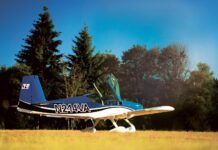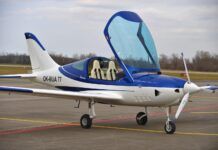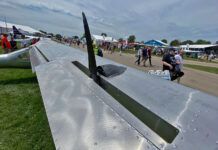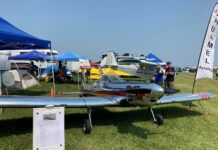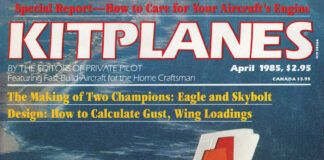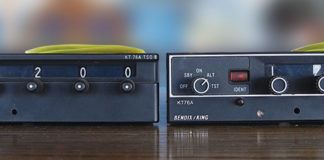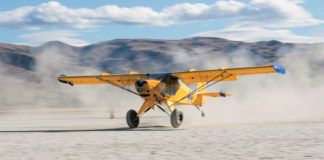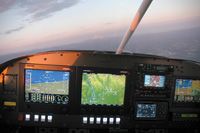During AirVenture/Oshkosh in July this year, the Light Aircraft Manufacturers Association (LAMA) presented its 16th annual Presidents Award to a person whose work-both professionally and as a volunteer-has had a major positive effect on ultralights, homebuilts and now on the majority of factory-built Light Sport Aircraft (LSA). This years winner is Eric Tucker, whose work with Rotax engines has coincided with the massive acceptance of these lightweight, powerful and durable aircraft powerplants.
An Introduction
Starting with his childhood, Canadian Eric Tucker has been fascinated with engines and the sport vehicles they propel. Learning to maintain motorcycle engines led to employment building, testing and successfully racing snowmobiles and becoming an expert on their propulsion. That introduced him to Rotax high-performance, two-stroke engines and resulted in his winning major U.S. and Canadian snowmobile races in the early 70s. It also led to honing his leadership skills, as he became a director of the Western Snowmobile Racing Federation where he helped develop internationally accepted racing rules.
In the early 80s, Tucker became an engine consultant for Ron Shettler, who convinced Rotax headquarters in Austria to develop engines for ultralights. Shettler and Tucker were largely responsible for the successful introduction of the two-stroke Rotax 277, 377, 447, 503, 532 and 582 engines used in thousands of ultralights. Some of these were liquid cooled, paving the way for the Rotax four-stroke aviation engine, whose development began in 1984. The resulting Rotax 912 and turbocharged 914 use liquid cooling for the heads and air cooling of the cylinders.
Under his own company (Engine Tech, in Vernon, British Columbia), Tucker produced the first aircraft Rotax operators manuals, and he trained ultralight designers who planned to use Rotax two-stroke engines in their flying machines. Working with Kodiak Research of Nassau, Bahamas-the Rotax distributor that covers most of North and South America-Tucker proposed a service center network that still exists. In 1991, he found time to earn his pilots license from the FAA. He also established the Rotax Flying and Safety Club, which trained engine techs in the U.S., South America, Europe and Africa.
Early in the process, Tucker joined the volunteers who produced consensus standards for the new Light Sport Aircraft (ASTM Committee F37). He was elected vice chairman of the F37 executive committee and chairman of the cross-cutting subcommittee, which deals with common LSA concerns including approved LSA engines.
Quiet, diplomatic, well organized and highly competent technically are words that describe Tucker in his leadership role, and committee members voted for him to receive ASTMs Outstanding Leadership Award last year.
Based now in the Bahamas, Tucker travels the world as the preeminent expert on Rotax aviation engine integration in new designs plus operation, maintenance and training. There is plenty to do; more than half of the 55 LSAs currently approved by the FAA are powered with Rotax 912 engines.
What is LAMA?
The organization that presented Tucker with this years Presidents Award as Outstanding Individual is about to become important to some prospective LSA owners. Thats because LAMA has begun voluntary consensus standards audits of LSA companies, and manufacturers whose aircraft pass the audit will begin advertising the fact. “The audit program is our flag in the air,” said LAMA CEO Dan Johnson. “The individual pilot will care about LAMA, because the audit assures a worthy product.”
Johnson (who wrote this column for many years) notes that LSA marketing is also important. “Because the aircraft producers have been willing to market their goods alongside each other, this may be a model for approaching the greater public about the advantages of becoming involved in aviation,” Johnson said. “My personal ambition is to take that experience and ask marketers if there are things we could do together to grow all of aviation. So far, the
marketing effort has mainly reached pilots,” he said.
LSA companies certify to the FAA that their products meet the ASTM consensus standards, but the FAA does not verify the companies assertions. Some in the recreational aircraft industry wanted mandatory auditing, but many believe this would violate the intent of the Congressional mandate for community-originated regulations. More on the audit process shortly.
LAMA was co-founded in 1984 by engineers Larry Burke and Bill Sadler to benefit ultralight manufacturers and their customers. Early in the 90s, Burke helped draft the regulations for the new Primary Category aircraft that were to be flown by people with a new license known as Recreational Pilot. Nine companies initially proposed to build Pri Cat planes, but only three followed through. Only about 100 people trained for and earned the Rec Pilot license. The program failed.
Sadler retired from the LAMA board, leaving Burke and LAMA with no members and a limited purpose. Now we come to one of those full-disclosure statements: Burke wanted to recognize outstanding individuals in the kit-manufacturing community, just as the EAA has long recognized individual builders of gorgeous aircraft. He asked me to help him with an annual LAMA Presidents Award program, which began in 1992, and I agreed.
The LAMA Presidents Award
It works like this: Burke writes company leaders and asks them to nominate an outstanding individual in the light aircraft community. People are asked not to nominate themselves, a previous winner or anyone associated with their own company. The person who gets the most nominations wins.
Last spring, Burke sent more than 500 invitations for nominations, and he received responses from more than half. Among the 80 people nominated, Tucker won. The announcement is made from the flight line communications building on opening day of AirVenture at Oshkosh. The winner receives a plaque and gets his name (some women have come close to winning) on the permanent obelisk trophy displayed near the entrance of the EAA Museum.
In recent years, leaders other than manufacturers have won the award. They have included Dick VanGrunsven of Vans Aircraft, Tom Peghiny of Flightstar and now Flight Design, journalist/publicist Dan Johnson, parts and engine supplier/maintainer Phil Lockwood and EAA Vice President Earl Lawrence, who heads the volunteer ASTM Light Sport Aircraft consensus standards committee.
Long ago, Burke asked me to join as a volunteer board member, and he and I constituted the LAMA board for several years. With the expected coming of LSA and Sport Pilot and a likely active role for LAMA, Burke and I invited several leaders to join us on the board. They were Lockwood, Peghiny, Johnson and former ultralight association executive Tom Gunnarson. Incidentally, no one on the board is paid or reimbursed for LAMA activities. Burke and others began promoting membership, and LAMA membership now totals more than 100 companies and organizations. Burke continues to be active on the board as chairman emeritus.
LAMA and ASTM Committee F37
In 2002, the FAA revealed the LSA/Sport Pilot proposal for public comment, and recreational aviation community meetings were called to respond to the new federally required consensus standards method of drafting federal regulations. The process is amazing. Instead of the usual practice of community response to FAA mandates, community volunteers write the standards and vote on them. Each represented company gets only one vote. As a member of the airplane and gyroplane subcommittees, I have the same one vote that the FAA has.
ASTM is a nonprofit testing standards company begun in the 1890s. Earl Lawrence had worked on the ASTM aviation fuel standards committee and recommended using the company as the organizational framework. ASTM agreed and assigned the code F37 to the new LSA committee. It does not charge a fee for its administrative services, which are vital to the process. Instead it makes money by selling the completed standards. (Committee members get a free copy.)
One of Burkes university degrees relates to quality assurance engineering, and he has experience in the field. He was elected secretary of both the F37 executive committee and the airplane subcommittee. This kind of work was right down his alley, and it relates to one of LAMAs primary roles, which is to promote recreational aviation while assuring safety. Each of the six original LAMA board members has been active on one or more of the F37 committees.
The LAMA Audit
The voluntary audit currently headed by LAMA board member/President Gunnarson, wearing his LAMA contractor hat, checks each consensus standard against a company’s record. The paperwork takes about two weeks, he says. That is followed by an onsite visit of about two days. Gunnarson is not an engineer, but engineer Adam Morrison of Slipstream Design checks on the technical details such as whether the company used an appropriate test and calculated the result correctly.
“The audit serves the goal of safety and satisfies FAA and others by showing how the industry is self-regulating,” Gunnarson notes. IndUS, which manufactures Thorpedo T-21 parts in India and assembles the aircraft in Texas, was first to take and pass the LAMA audit. By now several European LSA companies have been audited. Those passing receive a certificate of compliance and are offered serialized stickers for their individual aircraft. The current price for the company audit including the technical checkup is $3950 plus expenses such as transportation and lodging. A second aircraft type at the same manufacturer costs $1500. Gunnarson has grouped European audits together to save travel expenses. LAMA receives a small portion of the fee for its coordinating role.
So far the audits have turned up a few discrepancies that have to be cleared before compliance may be advertised. In that respect, the program appears to be working.
Currently, both EAA and FAA officials (including FAA Administrator Marion Blakey) strongly encourage LSA companies to schedule the LAMA audit. Company membership in LAMA costs $500, and associate members pay $250 per year.
What’s New?
At AirVenture, two newcomers joined the LAMA board. One is Jo Konrad from Germany. He is working with the European light-aircraft community to adopt the U.S. LSA standard. The other new board member is Jack Pelton, CEO of Cessna Aircraft, which accepted more than 500 deposits representing $63 million worth of sales of Cessnas SkyCatcher LSA during the first four days at AirVenture.
With the coming of LSAs, LAMA has changed quite a lot since the days when Larry Burke and I constituted the organization. Back then our major role was to announce the annual Presidents Award winner.
For more information on the Light Aircraft Manufacturers Association, visit www.lama.bz.




